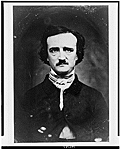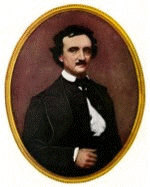|

|
Chapter 3:
Nineteenth Century to 1865
Romanticism
Edgar Allan Poe
1809-1849
|
©
Paul P. Reuben
January 10, 2020
E-Mail
|
 Fifth International Edgar Allan Poe Conference: April 8-11, 2021
Fifth International Edgar Allan Poe Conference: April 8-11, 2021
Poe Studies Association
Page Links: |
Primary
Works |
Influence
of Poe |
Major
Themes |
Paradoxes
in Poe |
Four
Types of Short Stories
| Aesthetic
Theory of Effect
|
| Selected
Bibliography: Biographical: 2000-Present
Critical: 2000-Present
|
| Study
Questions |
MLA Style
Citation of this Web Page
|
Site Links: |
Chap
3: Index
|
Alphabetical
List
|
Table
Of Contents
| Home
Page
|
Primary
Works
Tamerlane and
Other Poems, 1827 (poems); Al Aaraaf, Tamarlane, and Minor
Poems, 1829 (poems); Poems: Second Edition, 1831
(poems); "Ms Found in a Bottle," 1835; Politan - A Tragedy,
1835 (play); The Narrative of Arthur Gordon Pym of
Nantucket, 1838 (novel); Tales of the Grotesque and
Arabesque. 2 vols., 1840 (stories); The Prose Romances,
1843 (stories); Tales, 1845 (stories); The Raven and
Other Poems, 1845 (poems); Eureka: An Essay on the Material
and Spiritual Universe, 1848 (criticism).
Burtons' gentleman's
magazine and American monthly review (later title Graham's
illustrated magazine). Philadelphia: G. R. Graham, 1840-1856.
LAC: v.19 (1841)-v.33 (1848). LAC#31030-31037.
Collected works of
Edgar Allan Poe. 3 vols. Ed. Thomas Ollive Mabbott. Cambridge:
Harvard UP, 1969. PS2600 .F69
The complete poems and
stories of Edgar Allan Poe, with selections from his critical
writings. 2 vols. Ed. Arthur Hobson Quinn. New York: Alfred A.
Knopf, 1978. PS2601 .Q5
Essays and
reviews. New York: Viking Press, 1984. PS2619 .A1
The fall of the house
of Usher. Ed. Eric W. Carlson. Columbus, Ohio: Merrill, 1971.
PS2614 .A1
Letters. Ed. John
Ward Ostrom. 2 vols. New York: Gordian Press, 1966. PS2631
.A33
Literary criticism of
Edgar Allan Poe. Ed. Robert L. Hough. Lincoln: University of
Nebraska Press, 1965. PS2619 .A1
Marginalia. Ed.
John Carl Miller. Charlottesville: University Press of Virginia,
1981. PS2622 .M3
The narrative of
Arthur Gordon Pym. Boston: D. R. Godine, 1973. PS2618
.N3
The unknown Poe: an
anthology of fugitive writings by Edgar Allan Poe, with
appreciations by Charles Baudelaire, Stephane Mallarme, Paul
Valery, J.K. Huysmans & Andre Breton. ED. Raymond Foye.
San Francisco: City Lights Books, 1980. PS2603 .F6
Quinn, Alice. ed.
Edgar Allan Poe & the Juke-Box: Uncollected Poems, Drafts,
and Fragments. NY: Farrar, Straus & Giroux, 2006.
The Narrative of
Arthur Gordon Pym of Nantucket. Frank, Frederick S. ed.
Peterborough, ON: Broadview, 2010.
| Top
| Major Themes
1. Love - usually
of a mourning man for his deceased beloved.
2. Pride - physical and intellectual.
3. Beauty - of a young woman either dying or dead.
4. Death - a source of horror.
Influence
of Poe
1. Influenced
writers of split personality.
2. Influenced literary criticism.
3. Influenced writers dealing with the disintegration of
personality.
Poe's
Four Types of Short Stories
1. Arabesque -
strange; use of the supernatural; symbolic fantasies of the human
condition; (Example - "The Fall of the House of Usher").
2. Grotesque - heightening of one aspect of a character (Example -
"The Man Who Was Used Up").
3. Ratiocinative - detective fiction (Example "The Purloined
Letter").
4. Descriptive (Example - "The Landscape Garden").
Poe's
Aesthetic Theory of Effect
1. "Unity of effect
or impression" is of primary importance; the most effective story
is one that can be read at a single sitting.
2. The short story writer
should deliberately subordinate everything in the story -
characters, incidents, style, and tone - to bringing out of a
single, preconceived effect.
3. The prose tale may be
made a vehicle for a great variety of these effects than even the
short poem.
Poe's main concern
focused upon matters of design, proportion and composition; his
use of effect meant the impact which a short work would
make upon a reader. In reviewing Hawthorne's Twice Told
Tales, he pointed out the writer's obligation and reward: "If
his very initial sentence tend not to be the outbringing of this
effect, then he has failed in his first step. In the whole
composition there should be no word written, of which the
tendency, direct or indirect, is not to the one pre-established
design. And by such means, with such care and skill, a picture is
at length painted which leaves in the mind of him who contemplates
it with a kindred art, a sense of the fullest
satisfaction."
Paradoxes
in Poe
1. His life -
basically insecure and highly emotional, but his writing is
structured.
2. He reflects the paradoxical time - there was the apocalyptic
sense of doom combined with the romantic innocence of
childhood.
3. Poe was a romantic writer, but he emphasized rationality.
4. He presents realistic details in gothic settings.
5. There is a paradox in Poe's critical thinking - he believed in
individual creativity but advocated classical norms - the ideal
length of a poem, suggested Poe, is 100 lines.
Selected
Bibliography: Biographical 2000-Present
Fisher, Benjamin F. ed.
Poe in His Own Time: A Biographical Chronicle of His Life, Drawn
from Recollections, Interviews, and Memoirs by Family, Friends, and
Associates. Iowa City: U of Iowa P, 2010.
Hutchisson, James M.
Poe. Jackson: UP of Mississippi, 2005.
Peeples, Scott. The
Afterlife of Edgar Allen Poe. Rochester, NY: Camden House,
2004.
Perry, Dennis R.
Hitchcock and Poe: The Legacy of Delight and Terror. Lanham,
MD: Scarecrow, 2003.
| Top
|Selected Bibliography: Critical
2000-Present
Baker, Dorothy Z.
America's Gothic Fiction: The Legacy of Magnalia Christi
Americana. Columbus: Ohio State UP, 2007.
Clack, Randall A. The
Marriage of Heaven and Earth: Alchemical Regeneration in the Works of
Taylor, Poe, Hawthorne, and Fuller. Westport, CT: Greenwood,
2000.
Freedman, William. The
Porous Sanctuary: Art and Anxiety in Poe's Short Fiction. NY:
Peter Lang, 2002.
Hutchisson, James M.
Poe. Jackson: UP of Mississippi, 2005.
Inge, Thomas M. and
Christopher P. Semtner. The Incredible Mr Poe: Comic Book
Adaptations of the Works of Edgar Allan Poe 1943-2007. Richmond,
VA: Poe Museum, 2008.
Jackson, Christine A. The
Tell-Tale Art: Poe in Modern Popular Culture. Jefferson, NC:
McFarland, 2012.
Levine, Stuart and Susan.
eds. Edgar Allan Poe: Eureka. Urbana: U of Illinois P,
2004.
Mills, Bruce. Poe,
Fuller, and the Mesmeric Arts: Transition States in the American
Renaissance. Columbia: U of Missouri P, 2006.
Mücke, Dorothea E. von.
The Seduction of the Occult and the Rise of the Fantastic
Tale. Stanford: Stanford UP, 2003.
Perry, Dennis R.
Hitchcock and Poe: The Legacy of Delight and Terror. Lanham,
MD: Scarecrow, 2003.
Quinn, Alice. ed. Edgar
Allan Poe & the Juke-Box: Uncollected Poems, Drafts, and
Fragments. NY: Farrar, Straus & Giroux, 2006.
Renza, Louis A. Edgar
Allan Poe, Wallace Stevens, and the Poetics of American Privacy.
Baton Rouge: Louisiana State UP, 2002.
Sova, Dawn B. Critical
Companion to Edgar Allan Poe: A Literary Reference to His Life and
Work. NY: Facts on File, 2007.
Stashower, Daniel. The
Beautiful Cigar Girl: Mary Rogers, Edgar Allan Poe, and the Invention
of Murder. NY: Dutton, 2006.
Tschachler, Heinz. The
Monetary Imagination of Edgar Allan Poe: Banking, Currency and
Politics in the Writings. Jefferson, NC: McFarland, 2013.
Willis, Martin.
Mesmerists, Monsters, and Machines: Science Fiction and the
Cultures of Science in the Nineteenth Century. Kent: Kent State
UP, 2006.
Zarei, Rouhollah. Edgar
Allan Poe: An Archetypal Reading. Amherst, NY: Cambria,
2013.
| Top
| Researcher Says Rabies, Not Alcoholism, May
Have Killed Poe
Reporter: Christopher Shea,
Chronicle of Higher Education, Sept. 1996
Edgar Allan Poe's is among
the most spectacular of literary deaths: He was discovered lying
outside a pub in Baltimore, trembling and raving. He died three days
later in a nearby hospital. Because Poe had been an alcoholic, his
death has usually been attributed to withdrawal from drink. Now a
researcher at the University of Maryland Medical Center says it is
likely that he was killed by rabies.
Poe slipped into a coma soon
after he was admitted to the hospital. He snapped out of it two days
later and spoke lucidly to visitors. Then he quickly spiraled
downward: Delirium overtook him and he fought with doctors until he
had to be restrained.
The fitful course of his
condition does not match the progression of alcoholism, according to
R. Michael Benitez, an assistant professor of medicine at the medical
center. Poe's family also swore that he had been abstinent for half a
year.
A patient with rabies
suffers from bouts of confusion as well as wild swings in his pulse
rate, which Poe's doctor documented.
Hydrophobia is another
symptom of rabies, and Poe reportedly could barely swallow the water
that was given to him. Poe was a cat lover, and it is possible that
one of his pets bit him. "I would say that the conclusion that he did
not die from alcohol is very solid," Dr. Benitez says. "All the facts
of the case fit the possible diagnosis of rabies, but we will never
know for sure." He analyzed the Poe case without knowing who the
patient was, as part of a weekly workshop in pathology at the medical
center. His findings were published in the September issue of
Maryland Medical Journal.
Study
Questions
1. Summarize Poe's theory of
aesthetics as he expresses it in "The Philosophy of Composition" and
discuss his application of that philosophy in "The Raven."
2. Explicate a short lyric
(The Lake, Preface, or To Helen) and discuss Poe's creation of the
persona of the poet.
3. Discuss The Sleeper, The
Raven, Annabel Lee, and Ligeia in light of Poe's statement, in "The
Philosophy of Composition," that "the death, then, of a beautiful
woman is, unquestionably, the most poetical topic in the
world&emdash;and equally is it beyond doubt that the lips best suited
for such topic are those of a bereaved lover."
4. Explain what Poe means by
his attempt to achieve "unity of effect," and trace the particular
ways he manages this in "Fall of the House of Usher," "The Man of the
Crowd," or "The Black Cat."
MLA Style
Citation of this Web Page
Reuben, Paul P.
"Chapter 3: Early Nineteenth Century - Edgar Allan Poe." PAL:
Perspectives in American Literature- A Research and Reference
Guide. WWW URL: http://www.paulreuben.website/pal/chap3/poe.html (provide
page date or date of your login).
| Top
|


